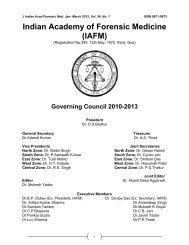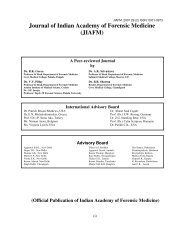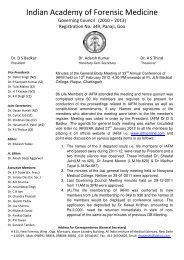Indian Academy of Forensic Medicine (IAFM) - Official website of IAFM
Indian Academy of Forensic Medicine (IAFM) - Official website of IAFM
Indian Academy of Forensic Medicine (IAFM) - Official website of IAFM
You also want an ePaper? Increase the reach of your titles
YUMPU automatically turns print PDFs into web optimized ePapers that Google loves.
J <strong>Indian</strong> Acad <strong>Forensic</strong> Med. October- December 2011, Vol. 33, No. 4 ISSN 0971-0973<br />
Original Research Paper<br />
A Study <strong>of</strong> rational use <strong>of</strong> Drugs among the Ophthalmic-in-<br />
Patients <strong>of</strong> a Government Teaching Hospital<br />
In View <strong>of</strong> <strong>Forensic</strong> Pharmacology<br />
*Kanchan Kumar Mondal, **Supreeti Biswas, ***Rajat Kanti Biswas, ****Anjan Adhikari,<br />
*****Biswajit Sukul, ******Saibendu Kumar Lahiri, *******Krishnangshu Ray<br />
Abstract:<br />
Inappropriate, irrational and cost-ineffective practices <strong>of</strong> pharmaceuticals are worldwide<br />
phenomena. A retrospective study was conducted among the Ophthalmic-in-patients to investigate the<br />
nature <strong>of</strong> utilization <strong>of</strong> drugs in respect <strong>of</strong> rationality correlating the clinical and forensic pharmacology.<br />
Prescriptions in the Bed Head Tickets were the study samples which were analyzed according to the<br />
WHO/INRUD Indicators. Incurred cost per day per prescription was calculated. Commonly prescribed<br />
drugs were also studied. Result revealed that proportion <strong>of</strong> drugs from Essential <strong>Medicine</strong>s List (EML)<br />
was 51.62%, while 54.05% was prescribed by generic names. Most commonly prescribed drugs were<br />
antibiotics (100%), analgesic-anti-inflammatory agents (100%) and mydriatic-cycloplegic agents<br />
(91.98%).<br />
Average number <strong>of</strong> drugs per prescription was 4.03±1.5 and average cost per day per<br />
prescription was 99.22 INR (<strong>Indian</strong> Rupees). Injectables were prescribed in 97.36% cases, and 10.81% <strong>of</strong><br />
total drugs (37) prescribed. Prescribing practices were not always in accordance with the WHO criteria for<br />
rational use <strong>of</strong> drugs. It is suggested that there is a felt need to provide more inputs to the<br />
Ophthalmologists to promote rational use <strong>of</strong> drugs.<br />
Key Words: Essential medicine, Fluoroquinolones, INRUD indicators, Mydriatics, Polypharmacy<br />
Introduction:<br />
A number <strong>of</strong> interfaces exist between<br />
drugs, medical practice, and the law. It is<br />
essential in modern society that every individual<br />
involved in the health care system have at least<br />
a cursory exposure to those aspects <strong>of</strong> the law<br />
that are intimately involved with the practice <strong>of</strong><br />
medicaltherapeutics.‖[1]<br />
<strong>Forensic</strong> Pharmacology <strong>of</strong>fers a<br />
unique and comprehensible account <strong>of</strong><br />
pharmacological methods and knowledge<br />
dealing with illicit drug use, poisoning and<br />
toxicology, and the relevant aspects <strong>of</strong><br />
prescription writing. [1, 2]<br />
Corresponding Author:<br />
* Asso. Pr<strong>of</strong>. Ophthalmology, RGKMC, Kolkata.<br />
Email: kanchan.kr.mondal@gmail.com<br />
**Pr<strong>of</strong>. & HOD, Pharmacology, BMC, Burdwan<br />
***Demonstrator, Pharmacology, RGKMC, Kolkata.<br />
****Asst. Pr<strong>of</strong>. Pharmacology, RGKMC, Kolkata<br />
*****Asso. Pr<strong>of</strong>., FMT, NRSMC, Kolkata<br />
******Pr<strong>of</strong>. & Head, PSM, RGKMC, Kolkata<br />
*******Pr<strong>of</strong>., Deptt <strong>of</strong> Clinical & Experimental<br />
Pharmacology, & Director, Calcutta School <strong>of</strong> Tropical<br />
<strong>Medicine</strong>, Kolkata<br />
324<br />
It focuses on the detection, analysis,<br />
and consultation pertaining to the negligence in<br />
prescribing and administering drugs, and<br />
adverse drug effects that result in harm, criminal<br />
activity, or death. [1, 3] Drug utilization research,<br />
part <strong>of</strong> clinical pharmacology, explores the links<br />
between pharmacotherapeutics and forensic<br />
science (forgery <strong>of</strong> prescriptions).<br />
Inappropriate and cost-ineffective uses<br />
<strong>of</strong> pharmaceuticals are worldwide phenomena<br />
especially in the developing countries. [4] Drug<br />
utilization research may provide insights into<br />
different aspects <strong>of</strong> drug prescribing including<br />
pattern, determinants, outcomes <strong>of</strong> drug use and<br />
quality control cycle (signals <strong>of</strong> irrational use and<br />
interventions to improve drug use). [4]<br />
Rational use <strong>of</strong> drugs should be one<br />
which meets up patients‘ clinical needs in doses<br />
that meet their own individual requirements for<br />
an adequate period <strong>of</strong> time at the lowest cost to<br />
them and their community. [5] In spite <strong>of</strong><br />
extensive programs on rational use <strong>of</strong> drugs and<br />
the Essential <strong>Medicine</strong> List (EML) <strong>of</strong> WHO, [6]<br />
prescribing behavior has not been changed<br />
significantly. In the legal and ethical context<br />
special care needs to be taken, when treating<br />
institutionalized populations. [7] Several studies<br />
<strong>of</strong> drug utilization pattern for varieties <strong>of</strong> morbid









